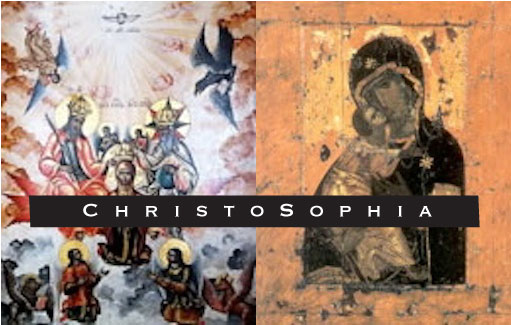
The Search for Sophia in Russia
It has long been our dream to go to Russia. For Richard, to visit Russia meant a spiritual return to his Orthodox faith: to see the beautiful Russian icons and cathedrals, to experience the sacredness of Orthodox monasteries, and to travel through Russian land which was a primary home of Orthodoxy for so many centuries. For me the reasons were more complex. The first one was primarily psychological. Growing up in the 1950’s during the Cold War, I was conditioned to think of the Russians as the “enemy.” The tribal thinking that initiates children into differentiating between “us” and “them” took the form of “good Americans” and “evil Communists.” The nightmares of my childhood were filled with terrifying images of nuclear war; again, the enemy that I feared was the Russians. Even though as an adult I have outgrown this conception with my rational mind, the emotional imprint of this early negative conditioning remains. So I hoped that the opportunity to actually go to Russia, see the places and meet the people that had served so long as the projecting screen for our cultural shadows, would be healing for my psyche. I believe that this form of personal inner work is necessary for the collective task of healing the conflicts between nations, racial, religious and ethnic groups that still plague us so violently today. The focus of the conflict has shifted from the Soviet Union to the Middle East and from Communists to Muslims, but the internal war is the same. So I envisioned my personal journey as one small step in our larger human journey toward reconciliation and peace.
My second reason for going to Russia centered upon my continual search for Sophia. Holy Wisdom has always maintained her place in Orthodox liturgy and been worshipped especially in Russia through her representation as Mary, Mother of God. Because Russia is known as a land of “dual faiths,” where the people maintained their pagan practices even as they embraced Orthodox Christianity, the divine feminine was not suppressed as she was in Western European cultures. In our contemporary world it has been the Russian Sophiologists who have been the primary “prophets of Sophia,” proclaiming her central role in the shaping of history and the evolutionary process of humanity. I hoped that in Russia I might find Sophia revealed more clearly than in Western culture. I wondered whether this would be the case after the repressions of the Soviet era and continuing political troubles, but determined that it was important for me to make the journey to Russia with my mind and heart open to receive Sophia’s presence wherever she might appear.
We finally were able to make our journey to Russia in September 2012 as part of an educational tour that included Moscow, St. Petersburg, Novgorod and the Golden Ring cities of Vladimir, Suzdal, Kostroma, and Yaroslavl. We visited many museums, churches, monasteries and historical sites, and had lectures on Russian culture, politics, art and music by university professors. Local guides in each area talked with us about the current situation in Russia and shared their personal stories with us. In this way I was able to “put a face” on the unknown enemy of my childhood fears and deeply realize our common humanity. Most importantly, it became clear to me that the United States and Russia have served as mirror images for each other’s projections of fear and hatred. As our lecturer Elena said, “To the Russians, America is the great enemy” as she added with a smile, “You are a great gift to us!” Both governments, which primarily have the welfare of the elite power group in mind, fan the flames of projected hatred toward the enemy in order to deflect the anger of the populace from the ruling classes. Hatred directed toward the Other helps maintain order and control within. It was deeply moving to me to hear our guide Snow tell about her experiences growing up during the Cold War and going through the same “duck and cover” exercises at school as we did. Except in her case, we were the enemy! I became even more aware of how crucial it is that we each do the work individually to withdraw our projections. As Elena also quoted, “It is not Stalin who is dangerous, but all the little Stalins in us.”
Through many such experiences I was able to achieve my goal of reconciliation with those who had been the feared enemy of my childhood. But at first it seemed that the results of my second goal, the search for Sophia, were more ambiguous. Throughout the journey I felt that I was catching just brief glimpses of her. Sophia plays hide and seek in Russia – at least for this American pilgrim on a group tour! I did not feel a spiritual presence in most of the cathedrals and monasteries we visited, which was disappointing but not surprising to me. Since most of the churches were closed during the Soviet times and religion was repressed, with a whole generation growing up in an atheistic culture, this is understandable. When churches were turned into museums they were stripped of their spiritual presence. Freedom of religion has been officially reinstated with the democratic reforms of the past 20 years, but the Orthodox Church hierarchy appears to be closely aligned with the authoritarian aims of the current government. Our lecturer Viktor summed up this situation when he said, “The Russian church is in search of its place in Russia today.”
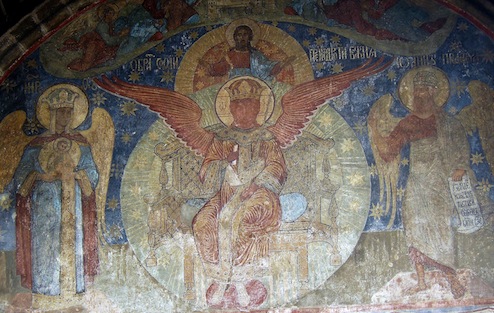
Sophia Icon on Dormition Cathedral, Moscow
And yet, through this turbulent time of transition, the Wisdom of Orthodox Christianity continues to be revealed in the sacred architecture of her domed churches, the transcendent beauty of her chant, and the profound spirituality of her icons. I came to know experientially that, as our lecturer Elena said, “Russian Christianity is a religion of the Feminine.” Her presence is invoked in the liturgy when the priest proclaims, “Sophia, Wisdom of the Highest” as he raises the Gospels to make the Sign of the Cross over the altar. Churches are dedicated to her, such as the Cathedral of St. Sophia that we visited in Novgorod. Icons portray the spiritual reality of divine Wisdom as a fiery, winged, crowned feminine figure sitting on her supernal throne, as we saw on the iconostasis at the Cathedral of St. Sophia and the outside of the Dormition Cathedral in the Kremlin, Moscow.
Icons have a unique role in Eastern Christianity as they present the mysteries of the faith through vivid, colorful imagery and are venerated for the spiritual realities they represent. The complex image of Sophia has deep inner connections with Jesus Christ, the Virgin Mary, and the Trinity that can be apprehended through prayerful receptivity to the inner wisdom of the icons. It is Russian mystics and philosophers such as Vladmir Solovyev and Sergei Bulgakov who have provided the most substantive theological context for interpreting these spiritual images and their interconnected meanings. I could understand the reason for this once I witnessed for myself the deep grounding of Sophia in the soul of Mother Russia. I also obtained a better understanding of the ideas of these Russian Sophiologists when I was able to encounter the icons, especially in their sacred context, that portrayed their theological concepts. It seemed to me that the silent images which spoke directly to my heart expressed the divine mysteries even more powerfully than all the words that attempt to describe them; even so, my attempt to integrate the images with the Sophiological writings has led me more deeply in the Mystery of Wisdom.
For the Russian Sophiologists, the Wisdom of God is the essence of the Trinitarian doctrine. Vladimir Solovyev described Sophia as the “substance” of the Trinity, “the divine principle of all-in-oneness, which is the Wisdom of God.”(1) In a similar manner, Sergei Bulgakov described Sophia as “the nature of God…a living…loving substance, ground, and principle.”(2) Each of the persons of the Trinity participates in the divine nature – Sophia, the Wisdom of God – yet remain independent of each other. This mystery of the faith, which transcends rational thought, was illumined for me when I saw an icon in the Russian Museum in St. Petersburg of the Coronation of the Virgin. In this image a divine feminine figure is being crowned by the three persons of the Trinity – Father, Son and Holy Spirit. The feminine reference is to the Virgin Mary, who is the primary representative of Sophia in Russian Christianity. In this icon we see Mary-Sophia as distinct from the Trinity, but central to the activity of Father, Son and Holy Spirit. This visual image portrays for me the paradoxical interdependence of Sophia and the persons of the Trinity in their uniqueness and relationship with each other. It is a symbolic expression of the passionate conviction of the Russian Sophiologists that the figure of Wisdom is central to the Christian faith.
The essential significance of Sophia for these Russian writers also pertains to her dual nature. Solovyev described both the transcendent figure of Wisdom and the World-soul, the presence of God in creation. Bulgakov referred to the Divine Sophia and the Creaturely Sophia, which is the created world. The Feminine, revered in earlier times as “Moist Mother Earth,” took the form of Mary the Mother of God when Christianity came to Russia. It is through the Sophianic nature of Mary that the created world continues to be honored in Russian religion. Another icon that I saw in the Russian Museum exemplified this for me. “In Thee All Creation Rejoices” portrays Mary seated on the Throne of Wisdom, which clearly reveals that she represents Sophia. She is surrounded by the glory of God, the manifestation of the divine in creation. As Bulgakov says, “She is created Wisdom, for she is creation glorified. In her is realized the purpose of creation, the complete penetration of the creature by Wisdom…The most holy Mother of God is the created Sophia…”(3) Mary’s representation as the Creaturely Sophia is also seen as she holds the Christ-child on her lap, signifying her central role in bringing the divine into human form. Bulgakov’s insight that “The image of the Mother of God with her child is an expression of the Incarnation of Divine-humanity”(4) illumines the Sophianic nature of the icons of Mary the Mother of God that the Russian Christian ardently reveres.
It is in his Divine-humanity that Jesus Christ also represents Sophia. Bulgakov states that “the Word…is himself the Wisdom of God,”(5) and the union of his divine and human natures relates to the Divine and Creaturely Sophia. Again, contemplation of the Russian icons helped me approach this mystical insight. The many icons of the Christ-child with his Mother such as my favorite, the Virgin of Vladimir which shows their loving embrace, reveals the deep humanity of Christ as incarnated Wisdom. While icons of Christ enthroned in majesty, depicted in the celestial realm and seated on the Throne of Wisdom, emphasize his depiction as the Divine Sophia.
This doctrine of Divine-humanity is a major theme of the Russian Sophiologists. It especially intrigues me as it forms the basis for their prophetic view of the future revelation of Sophia within our world. Bulgakov foretells “the fullness and unity of that life, at once divine and human, which Christ now lives, and which is to be extended, in the final fulfillment, to the whole world, the whole of Divine-humanity.”(6) Our lecturer Elena had pointed out that the sense of divine purpose in human history is an important strand in Russian philosophy and art. In Orthodox Christianity this is emphasized in the doctrine of theosis, the potential of the human being to be divinized, which is now only fully realized in Christ. Sophia, theologically understood as the essence of Divine-humanity, can be seen as the goal toward which the human race is striving.
As my prior study of the Russian Sophiologists awakened a new understanding in me when I contemplated the Russian icons, I felt that I was beginning to discern Sophia’s deep roots in the Russian soul. These initial glimpses culminated in a personal, direct encounter with her on my last day there. We went to the morning divine liturgy at Our Lady of Kazan Cathedral in St. Petersburg, which was my first time to participate in an Orthodox worship service. I was deeply moved by the mystical beauty of the service – the fragrant incense, ethereal chant, glow of candle light illuminating the golden icons – and experienced in a visceral way the reality of the Kingdom of Heaven within and all about me. As I stood among the devout worshippers – men and women of all ages making the Sign of the Cross repeatedly in response to the liturgy, old women making their prostrations, children held up in the arms of their parents to witness the drama – it came to me in a profound sense, “This is Sophia!” This is where Sophia is found today most clearly in Russia: the Wisdom that transcends rational knowledge by uniting body, heart and mind in the Mystery of the Orthodox liturgy. She is found in the uniting of individuals in the deepest recesses of the human soul, as I experienced in this collective worship, what the Christian tradition calls “the Mystical Body of Christ.” It is the Sophianic “all-in-oneness” of Solovyev, the multiplicity- in- unity that is the harbinger of the Kingdom of God upon the Earth. My unitive experience at Our Lady of Kazan marked the completion of this personal journey that I had undertaken to heal the split between “us” and “them” within myself.
Today we must expand our view to include not only Christians, but the entire human race, in our vision of the development of Divine-humanity that Sophiologists understand to be the divine purpose in human history. As I further reflected upon my experience at Our Lady of Kazan after returning home, I turned to another Russian Christian mystic of the 20th century, Daniel Andreev, who wrote a remarkable visionary book, The Rose of the World. He echoes the insights of the Sophiologists in his conception of the spiritual evolution of humanity that he represents as the Rose of the World. This is the symbol of the unity of the human race in all its diversity. When the Rose of the World finally blooms in its full beauty, we will celebrate the uniqueness that is expressed in difference while realizing our essential unity. Andreev believes that central to this process is the birth of the celestial Feminine, which is already occurring in the supernal realms of the Russian collective Soul. When this new birth is complete, all of the world’s wisdom traditions will unite, as the petals of one Rose, “to focus their combined energies on fostering humanity’s spiritual growth and on spiritualizing nature. Co-belief with all peoples in their highest ideals – this is what wisdom will teach.”(7) In this way the Sophianic impulse will unfold in the evolution of Divine-humanity through the historical process. We all contribute to this Divine-human task as we do our individual work to withdraw the fears and hatred that we project upon the Other, and as we unite in collective spiritual work that transforms human consciousness. This is the Sophianic potential that I recognized in my journey to Russia.
Russia throughout its turbulent history has remained the dwelling place of the hidden Sophia. Today, even in the midst of the continuing chaos of troubling times, the Sophia that has been hidden in the Russian soul – the Wisdom of Bulgakov that is the divinity hidden within the human race and the vision of Andreev of the birth of the divine Feminine – is ready to manifest in the collective human Soul. As I think back to our lecturer’s statement that “The Russian church is in search of its place in Russia today,” it seems very clear to me that its place in Russia – and in the world – lies in its Sophianic treasure. As Christopher Bamford says, “The future of living Christianity rests with the sophianic interpretation of the world and its destiny.”(8) When the Russian Church realizes its hidden treasure of Wisdom and gives it to a world that is ready to receive it, I will feel that my own outer and inner search for Sophia in Russia has been completed.
NOTES
1 Samuel D. Cioran, Vladimir Soloviev and the Knighthood of the Divine Sophia (Ontario: Wilfrid Laurier University Press, 1979), p. 21.
2 Sergei Bulgakov, Sophia: The Wisdom of God (New York: Lindisfarne Press, 1993), p.35.
3 Bulgakov, pp.126-127.
4 Bulgakov, p. 123.
5 Bulgakov, p. 137.
6 Bulgakov, p. 94.
7 Daniel Andreev, The Rose of the World (Hudson, New York: Lindisfarne Books, 1997), p. 67.
8 In Bulgakov, p.21.
Back to top
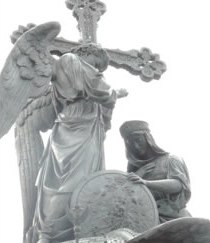
Angel Blessing “Mother Russia” in Novgorod
Holy Wisdom has always maintained her place in Orthodox liturgy and been worshipped especially in Russia through her representation as Mary, Mother of God.
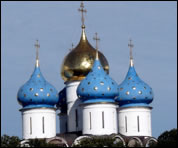
Sergiev Posad
Ancient center of
Russian Orthodoxy
The complex image of Sophia has deep inner connections with Jesus Christ, the Virgin Mary, and the Trinity that can be apprehended through prayerful receptivity to the inner wisdom of the icons.
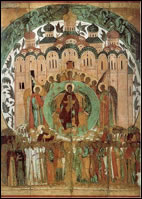
For the Russian Sophiologists, the Wisdom of God is the essence of the Trinitarian doctrine
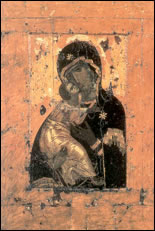
The essential significance of Sophia for these Russian writers also pertains to her dual nature… the transcendent figure of Wisdom and the World-soul, the presence of God in creation.
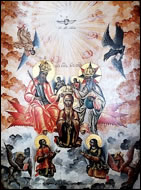
It is in his Divine-humanity that Jesus Christ also represents Sophia.
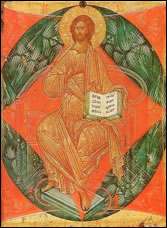
Sophia, theologically understood as the essence of Divine-humanity, can be seen as the goal toward which the human race is striving.
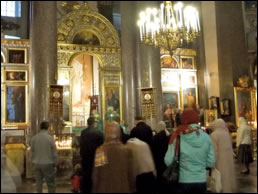
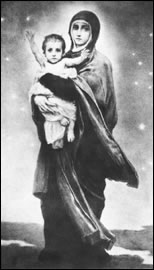
Viktor Vasnetsov: “Our Lady”